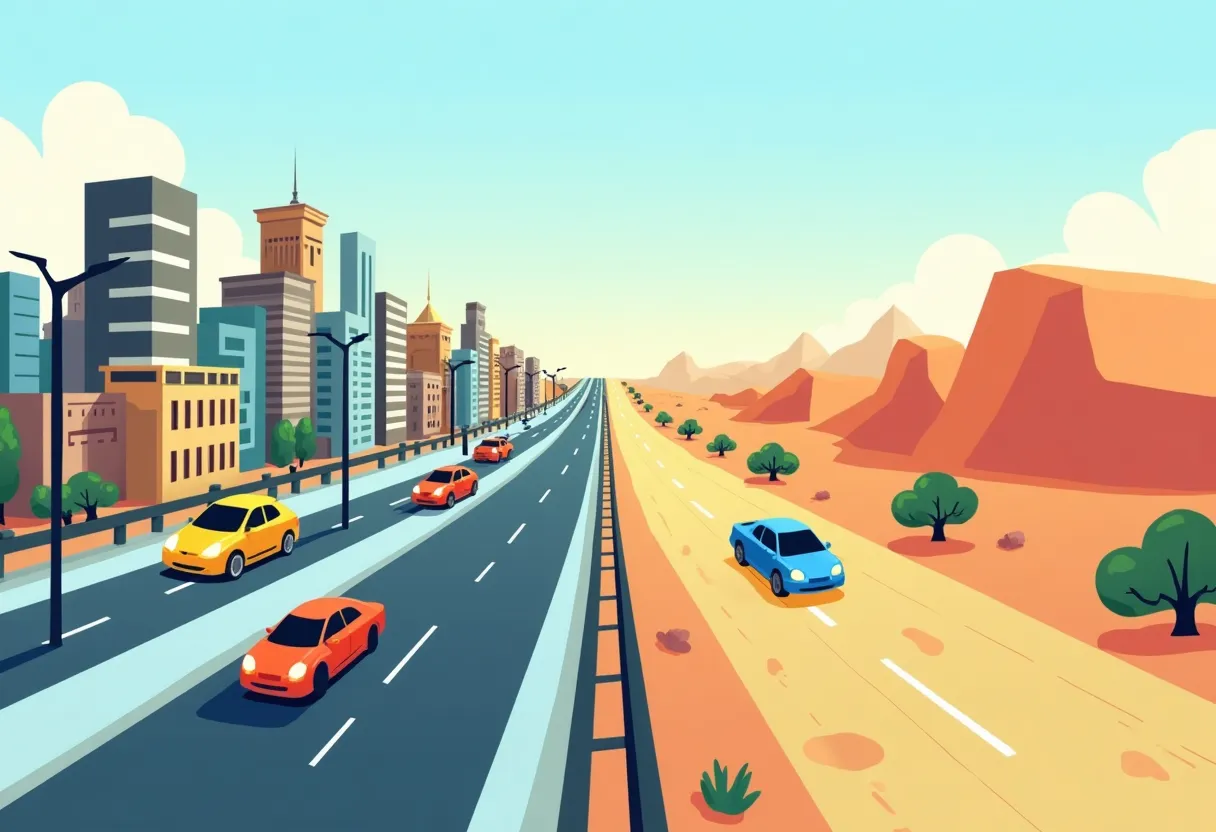The Complete Guide to Auto Insurance in Nevada: ban Sprawl vs. Desert Routes

Auto insurance in Nevada plays a crucial role in safeguarding both personal and commercial vehicles against the unique driving challenges presented by the state. Nevada's landscape is distinct, with the juxtaposition of urban sprawl in cities like Las Vegas and the expansive, often desolate desert routes that stretch across the state. This dual setting creates unique considerations for insurance providers and drivers alike. Understanding the intricacies of Nevada's auto insurance is even more critical when we consider its comparison with states like Ohio, which possess their own set of rural and urban driving challenges.
Explore the Auto Insurance in Nevada Series
This comprehensive guide is the central piece of Inaza’s Auto Insurance in Nevada series. Each piece of content in this series targets the complexities and tailor-fit solutions necessary for the varying environments within the state. Learn how automation, AI-driven processes, and operational efficiencies align with Nevada’s unique driving terrain.
- Automating Risk Assessment for High‑Desert Driving in Nevada
- AI‑Driven License & VIN Verification for Nevada MGAs
- Embedding Tourism‑Traffic Data into Nevada Underwriting Models
- Smart Fraud‑Check Automation for Nevada Insurers
- Rapid FNOL for Nevada Heat‑Related Breakdown Claims
- AI‑Powered Glass & Scratch Damage Assessment in Nevada Claims
- Automated BI Claim Injury Categorization for Nevada
- End‑to‑End Claims Pack Automation in Nevada
What Are the Key Differences Between Rural and Urban Auto Insurance in Nevada?
How Do Urban Areas Influence Auto Insurance Rates?
Urban areas in Nevada, such as Las Vegas, influence auto insurance rates by creating higher risk environments due to increased traffic congestion, higher crime rates, and a greater likelihood of accidents. These factors lead insurers to charge higher premiums in urban areas to offset the anticipated risk. Additionally, urban regions may have more comprehensive insurance requirements due to the higher incidence of vehicle theft and vandalism.
What Factors Affect Auto Insurance in Rural Nevada?
In rural Nevada, factors influencing auto insurance include long distances between towns, limited road maintenance, and wildlife-related incidents. Rural drivers might benefit from lower premiums due to fewer accidents and thefts; however, the lack of repair facilities and the higher costs associated with accidents in remote areas can impact the overall insurance considerations. These factors necessitate robust coverage options to address potential vehicle damage in less accessible regions.
Are There Unique Risks Associated with Desert Routes?
Desert routes in Nevada pose unique risks such as extreme weather conditions, scarce cellular signals, and isolation, which increase the complexity of roadside assistance and recovery services. Insurers account for these risks when assessing policies, urging drivers to consider comprehensive and collision coverages that protect against damages from sandstorms, flash floods, or breakdowns in remote areas.
What Types of Auto Insurance Coverage Are Available in Nevada?
What Are the Minimum Coverage Requirements in Nevada?
Nevada mandates a minimum liability coverage that includes $25,000 for bodily injury or death of one person, $50,000 for bodily injury or death of two or more persons, and $20,000 for property damage. These minimums ensure that drivers can cover some costs associated with accidents they cause, providing a critical baseline protection for all motorists.
How Do Optional Coverages Like Comprehensive and Collision Work?
Optional coverages, including comprehensive and collision insurance, offer additional protection beyond liability coverage. Comprehensive insurance covers damages from non-collision events like theft, vandalism, and natural disasters, while collision insurance covers damages resulting from collisions with other vehicles or stationary objects. Together, they provide comprehensive peace of mind, particularly valuable in Nevada’s varied landscape.
What Are the Benefits of Uninsured and Underinsured Motorist Coverage?
Uninsured and underinsured motorist coverage protects against accidents involving at-fault drivers who lack adequate insurance. This coverage ensures that policyholders are not left absorbing costs from an accident caused by someone else’s lack of coverage. Considering Nevada’s significant number of uninsured drivers, this coverage option is particularly prudent for mitigating financial risks.
How Does Sprawl Impact Auto Insurance Choices in Nevada?
What Are the Safety Concerns Related to Urban Sprawl?
Urban sprawl increases the potential for traffic accidents due to longer commutes and expanded road networks. This growth can strain existing infrastructure, leading to congestion and increased potential for accidents. Insurance companies may adjust rates to reflect these risks, emphasizing the need for comprehensive and collision insurance.
How Do Traffic Patterns Affect Claims and Underwriting?
The sprawling traffic patterns of Nevada's urban areas result in higher claim frequencies and more complex underwriting requirements. Insurance providers must anticipate patterns that affect risk exposure, using data analytics to fine-tune their risk assessments and set appropriate premium levels.
Are There Specific Insurer Considerations for Carriers in Sprawling Areas?
Insurers consider demographic shifts, increased traffic incidents, and the evolving infrastructure needs when developing policies for sprawling urban areas. Technological advancements, such as telematics and AI-driven analytics, help insurers better understand and manage risk within these expansive environments, resulting in more personalized and accurate pricing.
How Can Drivers Choose the Right Policy for Desert Driving in Nevada?
What Specific Coverages Should Desert Drivers Consider?
Desert drivers should consider coverage options that include roadside assistance, emergency services, and enhanced collision coverage to protect against the unique challenges of desert driving. Policies that cover towing, fuel delivery, and mechanical breakdowns are particularly valuable in Nevada's arid landscape.
How Does Weather Impact Auto Insurance in Desert Conditions?
Weather conditions in Nevada’s deserts, including extreme heat and sudden storms, can lead to higher rates of mechanical failure and weather-related damages. Insurers factor this into their risk assessments, and drivers are encouraged to adopt comprehensive coverage that guards against weather-induced damage.
What Resources Are Available to Help Drivers Make Informed Choices?
Drivers in Nevada can utilize online comparison tools, consult with local insurance agents familiar with regional risks, and review resources from the Nevada Division of Insurance. These resources help provide insights into policy options and coverage necessities, ensuring informed decision-making in selecting the ideal insurance plan.
What Role Does Technology Play in Auto Insurance for Nevada Drivers?
How Does AI Improve Claims Processing and Underwriting?
AI-powered technology revolutionizes claims processing and underwriting by enhancing data processing speed, accuracy, and predictive analysis capabilities. This leads to faster claims resolutions and more precise risk assessment, benefiting both insurers and policyholders through efficiency gains and cost savings.
What Are the Latest Innovations in Telematics for Auto Insurance?
Telematics technology, through devices like GPS and onboard diagnostics, allows insurers to monitor driving behavior, offering usage-based insurance options that reward safe driving. Nevada drivers can benefit from tailored premiums that reflect their actual driving habits, promoting safer roads through incentivized policies.
How Can Automated Proof-of-Insurance Checks Enhance Compliance?
Automated proof-of-insurance verification simplifies compliance for drivers and insurers, reducing paperwork and ensuring real-time updates to insurance status. This technology eliminates manual errors and enhances operational efficiency, benefiting policyholders through seamless and transparent transactional processes.
What Are Best Practices for Efficient Claims Handling in Both Environments?
How Can Automation Streamline the First Notice of Loss (FNOL)?
Automation in FNOL processes enables faster initial claim reporting, reducing time delays and ensuring immediate action on insurance claims. This leads to a smooth and efficient claims process, enhancing customer satisfaction by minimizing discomfort associated with claim-related waits.
What Data-Driven Insights Help in Managing Claims More Effectively?
Data-driven insights allow insurers to track and predict claims trends, identifying high-risk scenarios and potential frauds. Advanced data analytics in claims management leads to optimized resource allocation and effective decision-making, ultimately reducing costs and improving service levels.
How Does Improved Triage Impact Overall Customer Satisfaction?
Enhanced triage processes ensure that claims are prioritized accurately, based on urgency and the potential impact on policyholders. This precision in processing leads to better resource management and accelerates resolution times, boosting overall customer satisfaction and loyalty.
How Does the Nevada Auto Insurance Market Compare to Ohio?
What Are the Key Regulatory Differences Between Nevada and Ohio?
Nevada and Ohio exhibit notable regulatory differences, with Nevada focusing more heavily on tourism-related risks and desert driving conditions, while Ohio's regulations reflect concerns such as winter weather impacts and urban congestion. Each state’s regulatory framework influences local insurers’ strategic approaches to market adaptations.
How Do Risk Factors Differ in Auto Insurance for Each State?
Nevada's risk factors include desert weather conditions and urban sprawl challenges, whereas Ohio deals with winter storms and dense urban traffic risk. These unique state-specific risks require differentiated underwriting strategies and tailored policy offerings to address distinct environmental challenges.
What Lessons Can Ohio Drivers Learn from Nevada's Market Dynamics?
Ohio drivers can benefit from the market dynamics in Nevada by understanding the importance of comprehensive_weather-risk_coverage_and_the_benefits_of_using_technology_like_telematics_and_A._Even though the environmental challenges differ, leveraging technological advancements can empower policyholders to enjoy optimized auto insurance solutions.
Conclusion: Navigating Nevada’s Auto Insurance Landscape
In summary, navigating Nevada’s auto insurance landscape requires a nuanced understanding of both urban sprawl and rural desert challenges. Leveraging technology, from AI-driven underwriting to telematics, insurers and drivers alike can optimize coverage to enhance security and satisfaction in a diverse range of driving environments.
Regional nuances are vital in forming robust insurance strategies. Whether you are braving Nevada’s desert roads or managing the urban maze of Las Vegas, informed choices and technological adoptions are crucial for effective risk management. For bespoke guidance on full insurance optimization in Nevada and beyond, contact us today.
```




